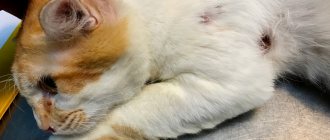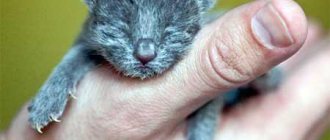During pregnancy, special care for the cat is important, as well as careful monitoring of its condition. The first sign of pathology is bloody discharge, which can accompany the development of diseases in the cat itself and in kittens. In addition, there are several blood release factors associated with physiological processes. In any case, the symptom cannot be ignored.
Causes of discharge
Bleeding in a pregnant cat can be light or heavy. A small amount of blood secreted often goes unnoticed, so it is important to pay attention to other symptoms - poor appetite, wet fur in the tail area, frequent licking of the vagina, restless mood of the pet.
The abundant release of blood from the loop is visible to the naked eye. The symptom can accompany a number of different pathological processes:
- inflammatory diseases of the genitourinary system, including the uterus, are accompanied by infection with pathogens that cause inflammation and bleeding;
- involuntary abortion - against the background of chronic diseases of the cat’s heart, lungs, kidneys, as a result of an incorrect approach to nutrition, with abnormalities in the development of the offspring, trauma to the uterus;
- Trauma to the uterus is a common cause of bleeding in cats during pregnancy; it occurs as a result of jumping, hitting, or falling. Most often, the pathology ends in abortion, with a high risk of death for the mother;
- intrauterine death of offspring develops against the background of infection of the genital organs, in the presence of developmental anomalies, placental insufficiency and other pathologies;
- placental abruption.
Also read the article about different types of discharge during pregnancy in cats.
Treatment
Let us immediately note that you will not be able to cope with uterine bleeding at home even if you want to. Only the help of an experienced veterinarian will help. In severe cases (more precisely, almost always), with serious bleeding, experts immediately recommend resection (that is, removal) of the uterus. Of course, your pet will no longer be able to have kittens, but her life is more important in this case. Please note that if the uterus and ovaries are removed, the cat will subsequently need hormone replacement therapy to avoid some of the unpleasant consequences of such an operation.
Are there any chances to avoid major surgery? In principle, there is. But only in cases where the bleeding is localized somewhere in the vagina or cervix. In such situations, the bleeding area can be cauterized, or a Foley catheter can be used. The administration of drugs that promote accelerated blood clotting is also indicated. In case of severe bleeding, it is advisable to administer blood-substituting compounds. Finally, in case of damage to the external genitalia, if it was their damage that led to the development of bleeding, resection of the affected tissue is performed, if possible suturing the wounds.
Proper feeding of a cat after a difficult birth accompanied by bleeding is of great importance. Since the animal’s body needs to replenish iron deficiency, beef liver and small amounts of lean red meat can be included in your pet’s diet. However, you should not give your cat heavy food immediately, but some time after giving birth: at first, her weakened body may not absorb the nutrients.
The danger of discharge according to the stages of pregnancy
During a normal pregnancy, there should be no bleeding throughout the entire period. Light bleeding during the prenatal period is allowed, one or two tablespoons. In this case, the blood should not have a dark or light color, additional pathological impurities and a specific or unpleasant odor.
Blood loss in the early stages of pregnancy indicates the presence of pathology and most often accompanies spontaneous abortion.
The appearance of a daub with an unpleasant odor, mixed with a greenish, brown tint may indicate a serious pathology of pregnancy and childbirth. This condition requires contacting a veterinarian.
Also read about how long a cat walks while pregnant.
Cat pregnancy
During this period, the fruits reach 8 cm in length.
Their weight is approximately 100 grams. every. Their bodies are covered with short fur. Motor activity appears, so the cat owner can observe wave-like vibrations in the abdomen of his pet (especially in a lying position). There is swelling of the mammary glands and the appearance of discharge from the vulva. During this period, it is difficult for the cat to walk; she lies down most of the day. The animal's appetite decreases sharply.
Precursors of childbirth in cats appear 3-5 days before the significant event. During this period, the animal tries to stay as close to the owner as possible, looks for a secluded place for itself, and shows noticeable anxiety. Lambing in a cat Precursors of childbirth in cats: restlessness, the desire to follow the owner literally on the heels, the appearance of mucous discharge from the “loop”. To alleviate your pet’s condition, try to prepare a secluded and cozy “nest” for her in advance. This could be an ordinary box covered with a clean diaper, a soft house, etc. It is also important to provide assistance to the cat during childbirth.
Ideally, a veterinarian should be present during this process. But with preliminary preparation, you can cope with this task yourself. Before your cat goes into labor, prepare the following tools: • clean scissors and nylon thread for tying the umbilical cord in kittens; • surgical gloves; • dry and clean cloth; • small syringe; • antiseptic agents, such as iodine, brilliant green, etc.
If you are about to deliver a British cat with a narrow pelvis or other problems, make an appointment with the veterinarian in advance, keep his phone number handy for advice or an emergency call. If these conditions are met, lambing will proceed without complications.
So, how does birth work in cats? The first stage - contractions, accompanied by bloody vaginal discharge, can last up to 12 hours. At this time, the animal rushes about, screams unnaturally, and tries to stay closer to the owner. Your task is to assist the cat during childbirth. Stroke and massage her belly, talk in a calm, quiet voice, calming the animal.
Childbirth in a cat lasts a maximum of 24 hours, usually 7-8 hours. The fewer kittens, the faster the lambing will be. It’s not difficult to remember how cat birth goes. Babies emerge from the birth canal head first. The mother must bite through the amniotic sac and then gnaw the umbilical cord. If kittens appear one after another, your task is to assist the cat during childbirth. Cut the bubble with scissors and gently wipe the baby. Then you need to cut the kittens' umbilical cord to a length of 1.5-2 cm from the baby's tummy.
The umbilical cord is tied with thread and treated with an antiseptic. Excess mucus from the baby's nose and mouth can be removed with a syringe, gently tilting the baby's head down.
If the above steps are performed correctly and there are no pathologies, the cat will give birth quickly and without complications. However, during the first few weeks you need to closely monitor any changes in your pet’s condition or behavior, contacting your veterinarian at the first alarming signs.
Often after giving birth, a cat will experience bleeding for 2-3 weeks. If such discharge is insignificant, your pet’s body temperature is not elevated, and her appetite and behavior are normal, there is no need to panic. Such manifestations are not considered deviations from the norm. If the animal vomits, refuses food, or has diarrhea, urgently take your cat to the doctor or call a specialist to your home!
Normal and dangerous discharge
The first three weeks may be accompanied by pale pinkish discharge from the vagina; such a symptom, as a rule, is not a sign of any pathology and does not require treatment.
On the eve of delivery, mucus begins to leak, which can acquire a yellowish or greenish tint without an unpleasant odor. With the onset of contractions, blood begins to be released. Normally, its volume is from one to two tablespoons, depending on the weight of the cat, and the duration of bleeding does not exceed 10 minutes. The discharge has a normal color - not dark and not too light, without green or brown impurities.
We recommend reading the article about whether a pregnant cat can be sterilized.
The discharge of blood from the loop in a pregnant cat can signal many pathologies. Depending on the cause, the pathological fluid will differ in its characteristics.
- Bleeding lasting more than ten minutes, accompanied by the release of bright scarlet blood, is most often a sign of trauma to the uterus. In this case, the pathology is characterized by heavy blood loss - more than two tablespoons. The clinical picture is represented by lethargy of the cat, increased breathing, which is subsequently replaced by a decrease in breathing, and tachycardia. Massive blood loss leads to the death of the animal, so this condition is an indication to contact a specialist.
- A viscous green secretion may accompany intrauterine fetal death. The condition can be complicated by infection of the cat’s internal organs, sepsis and lead to death. The pathology requires prompt extraction of the offspring through surgery.
- Dark or dark brown fluid from the cat’s genital tract, which appears at various stages of pregnancy, is most often a sign of placental abruption, intrauterine death of the offspring. Both pathologies pose a threat to the pet’s life, so you should seek the help of a specialist. Treatment will depend on the individual characteristics of the animal, the cause of the pathological discharge and other factors. A wait-and-see approach with medication, induction of labor, or cesarean section may be chosen.
- The appearance of pus from the genital tract accompanies infectious diseases. Lack of therapy can lead to the death of offspring, sepsis and other complications, so the owner should contact a veterinarian. Treatment depends on the severity of the disease and the condition of the fetus. Both a course of antibiotic therapy and artificial termination of pregnancy may be prescribed.
Also read the article on how to tell if your cat is pregnant.
When is everything within normal limits, and when is it time to panic?
First, let's clarify one important circumstance: in general, the release of small amounts of blood during childbirth is a completely normal phenomenon, and there is no need to worry.
According to biologists and veterinarians, a cat can lose up to 40 ml of blood during the birth of kittens.
Considering that in an animal weighing four kilograms there is no more than 200 ml of the latter, the blood loss is quite serious. It is for this reason that the animal may not feel the best immediately after giving birth: your pet will be lethargic, at first refusal to eat and general “stunning” are normal. Thus, blood itself is not a reason to panic.
But still, in the cases described below, it does not hurt to contact a veterinary specialist as quickly as possible:
- Blood is released in a trickle even after the birth of the last kitten.
- In normal cases, of course, some amount of blood is also released from the external genitalia of the animal, but it has a dark tint and some pieces can be seen in it (remnants of the placenta and exfoliated endometrium). But with “classic” bleeding, the blood will be expected to have a bright red or even scarlet hue. In this case, we recommend that you contact a specialist immediately.
- The animal gradually becomes more and more lethargic, and with each contraction of the uterus during labor contractions, increasingly large portions of blood or blood clots are released.
Thus, in cases where a small amount of blood is released during childbirth, there is no need to panic - everything is fine.
If a real “stream” begins to flow from your pet’s noose, then calling a veterinarian in a timely manner is far from an unnecessary precaution.
What to do if your pregnant cat is bleeding
If a pregnant cat experiences bleeding that lasts more than ten minutes and exceeds the permissible amount, you should contact your veterinarian. Untimely treatment can lead to the death of not only the fetus, but also the cat.
The doctor will prescribe the necessary studies that will help make the correct diagnosis and choose treatment tactics.
To avoid bleeding from your cat during pregnancy, you must:
- monitor the animal’s nutrition;
- check the condition of the loop and hair in the tail area for traces of pathological discharge;
- do not expose your pet to stress;
- avoid traumatizing the cat’s abdomen;
- Avoid hypothermia and overheating of the animal.
1111
Red bleeding after mid-pregnancy
But, if your pregnant cat develops reddish blood spots during the late stages of pregnancy or at the end, then it is likely that she will go into labor. So, if there is a week left in the pregnancy, the birth will occur prematurely, but if it has already occurred in the days close to the completion of the pregnancy process, then there is no need to worry as it will happen at the appropriate time.
If it is in advance, it is best to contact our veterinarian to check our pet and monitor the delivery process, in which some kittens will likely come out smaller than usual.
Likewise, to know that a cat is giving birth, another indicator that will indicate that the time has come is that mucus appears along with a little bleeding, that is, the female will dislodge the mucus plug, which is equivalent to the water breaking in women.
© shutterstock
conclusions
In order for a cat to give birth to healthy offspring, you need to monitor its condition.
We repeat that if any of these signs appear, you must immediately report it to the nearest available veterinary office to help your pet endure this important but difficult process. Careful monitoring of your own furry will help not only to avoid problems with childbirth (and pregnancy in general), but also to tie your pet even closer to you, because the animal will be grateful to you for this.
Tumor formations in the intestines
The appearance of blood from the pet's anus is one of the symptoms of neoplasms in the intestines. Such tumors are rarely diagnosed in cats and often have a poor prognosis. The sooner the cat's owner seeks veterinary help, the higher the likelihood of successful treatment of the animal. The causes of this disease are not fully understood. In the course of research, it was possible to establish that representatives of the Siamese breed have a predisposition to intestinal cancer.
Most often, these animals have such types of formations as nutritional lymphoma, intestinal adenocarcinoma and mastocytoma. The disease is accompanied by the following symptoms:
- loss of appetite;
- weight loss;
- nausea and vomiting;
- stomach ache;
- pallor of the mucous membranes;
- lethargy, apathy;
- bloody diarrhea.
How to treat?
The owner needs to be close to the pet at such an important moment and monitor so that no complications occur.
Clear, light pink bleeding before childbirth is considered normal, so treatment is not required. The owner needs to monitor the pet’s condition, calm her down during childbirth, and do everything to ensure that the process ends safely. At the same time, during childbirth, it is important to pay attention to the nature of the amniotic fluid, color, and smell. If you have any suspicions, it is better to tell everything to the veterinarian, who will refer you for additional examination and, if necessary, prescribe restorative treatment. In case of uterine abruption, when bloody discharge comes from under the tail, the doctor first of all takes into account the timing of pregnancy. In the later stages, constant monitoring is carried out, and comprehensive analyzes are carried out. Delivery usually occurs without complications unless the animal has other health problems. If abruption occurs in the first half of pregnancy, and the bleeding is profuse, there is no other choice but to artificially induce labor, since the cat may die.
No less dangerous than bloody discharge are purulent discharges, which are often the result of the death and decomposition of one or more fetuses. In such situations, the veterinarian prescribes effective antibiotics and other drugs to avoid complications. If the condition does not return to normal, the doctor will suggest a cesarean section or termination of the pregnancy to save the animal’s life. After surgical treatment or urgent induction of labor, long-term rehabilitation under the supervision of a physician will be required.











